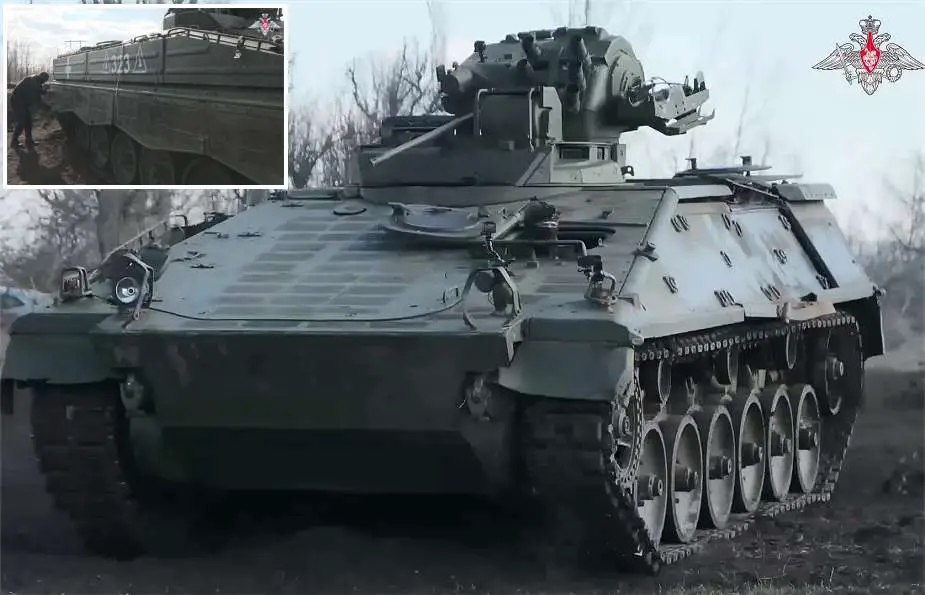Russia Restores and Analyzes Captured Ukrainian Marder 1A3 IFV in Revealing Video
A video released on April 1, 2024, by the Russian Ministry of Defense has provided a detailed look at a captured Ukrainian Marder 1A3 Infantry Fighting Vehicle (IFV), showcasing the efforts of the Russian army's engineering and repair units in studying and restoring the vehicle. The capture of the Marder 1A3, a German-made armored vehicle, was first reported on March 26, 2024, by the editorial team of Army Recognition. According to the reports, the vehicle fell into Russian hands in the Avdeevsky area, secured by soldiers from the Center group of forces.
Follow Army Recognition on Google News at this link

Russian soldiers refurbished captured Ukrainian Marder 1A3 to probe its defense technology prowess. (Picture source Russian MoD video footage)
The footage reveals not only the Marder 1A3 in detail but also outlines the methodical approach adopted by the Russian forces to capture and recover such vehicles from the battlefield. The operation to secure and evacuate the Marder was executed in two critical phases, ensuring the safety of both personnel and equipment involved. Initially, an engineering reconnaissance was conducted to assess and mitigate any risks in the evacuation area. Following this, the vehicle was carefully evacuated to a repair unit for further assessment and restoration.
Repair efforts on the Marder were comprehensive, with specialists focusing on critical areas of damage. The video detailed the replacement of damaged fuel and cooling system lines, the repair of the radiator, and the substitution of fuel pumps, which were crucial steps in bringing the vehicle back to operational status. Thanks to the meticulous work of the repair unit, the Marder was reported to be able to move independently post-restoration.
The release of this video and the detailed account of the capture and repair process highlight the ongoing intensity and complexity of the conflict in Ukraine. It also showcases the significant technological and logistical efforts involved in modern warfare, including the recovery and repair of captured enemy equipment for further study and potential reutilization. The tactical insights provided by such operations are invaluable for understanding and adapting to evolving warfare dynamics.
The capture of the Ukrainian Marder 1A3 Infantry Fighting Vehicle (IFV) by Russian forces and its subsequent public showcasing has far-reaching implications for Ukraine as well as the German defense industry, which manufactures the Marder 1A3.
The Marder 1A3 represents one of the latest generations of modern IFV (Infantry Vehicle), encapsulating advanced engineering and tactical versatility within the framework of armored warfare. As a highly developed variant of the Marder family, it integrates enhanced armor protection and superior firepower. Recently, an anti-drone system mounted by the Ukrainians has been added, making it a formidable platform for infantry support and mechanized operations on contemporary battlefields.
For Ukraine, the loss of the Marder 1A3 is significant both tactically and operationally. The Marder 1A3 is known for its robust armor, firepower, and mobility on the battlefield, making it a critical asset for infantry support operations. Losing such a vehicle not only depletes Ukraine's armored capabilities but also affects the morale of its troops. Furthermore, the potential extraction of sensitive technology and tactical information by Russian forces could compromise operational security and the effectiveness of remaining vehicles and strategies employed by the Ukrainian military.
The impact on the German defense industry could be multifaceted. The public display of a captured Marder 1A3 undergoing examination and repair by Russian forces raises concerns about the security and vulnerability of Western military technology. There might be fears of reverse engineering or exploitation of the vehicle's technology, which could potentially lead to the development of countermeasures or improvements in Russian military capabilities. Such incidents could prompt a reassessment of export policies and operational security measures by the German defense sector to prevent future compromises. Additionally, the incident may influence future design and development decisions, with an increased focus on countermeasures against capture and technology exploitation.
Overall, the capture of the Marder 1A3 underscores the complexities of modern warfare, where the loss of advanced military equipment can have strategic implications beyond the immediate tactical disadvantages. It highlights the ongoing challenges faced by Ukraine in safeguarding its military assets and poses questions for the German defense industry about ensuring the security of its technology in conflict zones.
Defense News April 2024
- Hits: 4333
















